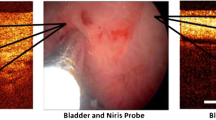Abstract
The aim of this study was to assess the potential of probe-based confocal laser endomicroscopy (pCLE) as a new diagnostic imaging technique for the male genital tract. For this purpose, testes, epididymides, and vasa deferentia were obtained during transsexual surgery of healthy patients (n = 10, 26–52 years). Prior to this, testes of rats (n = 10, Sprague–Dawley) and mice (n = 8, wild-type) were examined. Ex vivo tissues were investigated by pCLE after topical fluorescence staining. Images and pCLE real-time video sequences were compared to images acquired by confocal laser scanning microscopy (CLSM); this allowed the identifying of corresponding microstructures. Interestingly, the seminiferous tubules of transsexual humans contained mainly spermatogonia due to long-term estrogen treatment, whereas the seminiferous tubules of the murine and rat spermatogenesis-related cell types were differentiated. Mosaicking improved the inspection potential by wide-angle views. Similarly, the microarchitecture of the epididymis and the vas deferens was successfully visualized in situ and on a cellular level by pCLE. In summary, pCLE allows for real-time identification of relevant microstructures responsible for spermatogenesis under ex vivo conditions. Additionally, pCLE enabled to localize vital spermatozoa in the testis thus opening up new ways to improve sperm retrieval rates during assisted reproduction. Both clinically relevant experiences hold promise to introduce this diagnostic method into a clinical study, and to investigate its potential as a clinical diagnostic procedure to expedite and improve the medical situation.




Similar content being viewed by others
References
Bedford JM, Hoskins DD (1990) The mammalian spermatozoon: morphology, biochemistry and physiology. In: Lemming GE (ed) Marshall’s physiology of reproduction. II. Reproduction in male. Longman, UK, pp 379–568
Rushambuza RP (2013) The role of diagnostic CT imaging in the acute assessment of battlefield external genital injuries. JR Army Med Corps 159:S21–25
Woldrich JM, Im RD, Hughes-Cassidy FM et al (2013) Magnetic resonance imaging for intratesticular and extratesticular scrotal lesions. Can J Urol 20:6855–6859
Kitajima K, Nakamoto Y, Senda M et al (2007) Normal uptake of 18F-FDG in the testis: an assessment by PET/CT. Ann Nucl Med 21:405–410
Dierickx LO, Huyghe E, Nogueira D et al (2012) Functional testicular evaluation using PET/CT with 18F-fluorodeoxyglucose. Eur J Nucl Med Mol Imaging 39:129–137
Fujimoto J, Drexler W (2008) Introduction to optical coherence tomography. In: Drexler W, Fujimoto J (eds) Optical coherence tomography: technology and applications. Springer, Berlin, Heidelberg, pp 1–45
Flannery BP, Deckman HW, Roberge WG et al (1987) Three-dimensional X-ray microtomography. Science 237:1439–1444
Schulze W, Thoms F, Knuth UA (1999) Testicular sperm extraction: comprehensive analysis with simultaneously performed histology in 1418 biopsies from 766 subfertile men. Hum Reprod 14:S82–96
Donoso P, Tournaye H, Devroey P (2007) Which is the best sperm retrieval technique for non-obstructive azoospermia? A systematic review. Hum Reprod Update 13(6):539–549
Takada S, Tsujimura A, Ueda T et al (2008) Androgen decline in patients with nonobstructive azoospemia after microdissection testicular sperm extraction. Urology 72:114–118
Ohya TR, Sumiyama K, Takahashi-Fujigasaki J et al (2012) In vivo histologic imaging of the muscularis propria and myenteric neurons with probe-based confocal laser endomicroscopy in porcine models. Gastrointest Endosc 75:405–410
Inoue H, Igari T, Nishikage T et al (2000) A novel method of virtual histopathology using laser-scanning confocal microscopy in-vitro with untreated fresh specimens from the gastrointestinal mucosa. Endoscopy 32(6):439–443
Newton RC, Kemp SV, Yang GZ (2012) Imaging parenchymal lung disesases with confocal endomicroscopy. Respir Med 106:127–137
Salaün M, Bourg-Heckly G, Thiberville L (2010) Confocal endomicroscopy of the lung: from the bronchus to the alveolus. Rev Mal Respir 27:579–588
Templeton A, Hwang JH (2013) Confocal microscopy in the esophagus and stomach. Clin Endosc 46(5):445–449
Nakai Y, Isayama H, Shinoura S et al (2014) Confocal laser endomicroscopy in gastrointestinal and pancreatobiliary diseases. Dig Endosc 26:S86–94
Wu K, Liu JJ, Adams W et al (2011) Dynamic real-time mircroscopy of the urinary tract using confocal laser endomicroscopy. Urology 78:225–231
Wani S, Shah RJ (2013) Probe-based confocal laser endomicroscopy for the diagnosis of indeterminate biliary strictures. Curr Opin Gastroenterol 29(3):319–323
Trottmann M, Stepp H, Sroka R et al (2014) Probe-based confocal laser endomicroscopy (pCLE)—a new imaging technique for in situ localization of spermatozoa. J Biophotonics. doi:10.1002/jbio.201400053
Yigitsoy M, Navab N (2013) Structure propagation for image registration. IEEE Trans Med Imaging 32(9):1657–1670
Najari BB, Ramasamy R, Sterling J et al (2012) Pilot study of the correlation of multiphoton tomography of ex vivo human testis with histology. J Urol 188(2):538–543
Ramasamy R, Sterling J, Fisher ES (2011) Identification of spermatogenesis with multiphoton microscopy: an evaluation in a rodent model. J Urol 186(6):2487–2492
McEnerney JK, Wong WP, Peyman GA (1977) Evaluation of the teratogenicity of fluorescein sodium. Am J Ophthalmol 84(6):847–850
Carvalho JO, Sartori R, Machado GM et al (2010) Quality assessment of bovine cryopreserved sperm after sexing by flow cytometry and their use in in vitro embryo production. Theriogenology 74:1521–1530
Rath D, Johnson LA (2008) Application and commercialization of flow cytometrically sex-sorted semen. Reprod Domest Anim 43:S338–346
Acknowledgments
We thank Mr. Myles Leavy for final proof reading.
Author information
Authors and Affiliations
Corresponding author
Ethics declarations
Ethical statement
This study was approved by the Ethics Committee of the University of Munich (project number 161-12). The use of the dead animals had been approved by the Institutional Animal Care and Use Committee (IACUC).
Conflict of interest
No competing financial interests exist.
Electronic supplementary material
Below is the link to the electronic supplementary material.
Movie 1
Real-time view of a human testicular tubule mainly containining spermatogonia (staining: AC). (MPG 1132 kb)
Movie 2
Visualization of manipulations in human testicular tubules by pCLE. The contents of a tubulus contortus is pressed out which is recorded in real-time (staining: FITC). (MP4 434 kb)
Movie 3
In situ localization of spermatozoa in the human epididymis (see circular line, staining: FA). (MP4 2336 kb)
Rights and permissions
About this article
Cite this article
Trottmann, M., Sroka, R., Stepp, H. et al. Probe-based confocal laser endomicroscopy (pCLE): a preclinical investigation of the male genital tract. Lasers Med Sci 31, 57–65 (2016). https://doi.org/10.1007/s10103-015-1828-0
Received:
Accepted:
Published:
Issue Date:
DOI: https://doi.org/10.1007/s10103-015-1828-0




